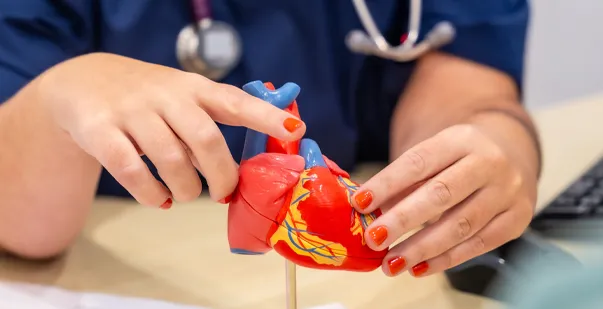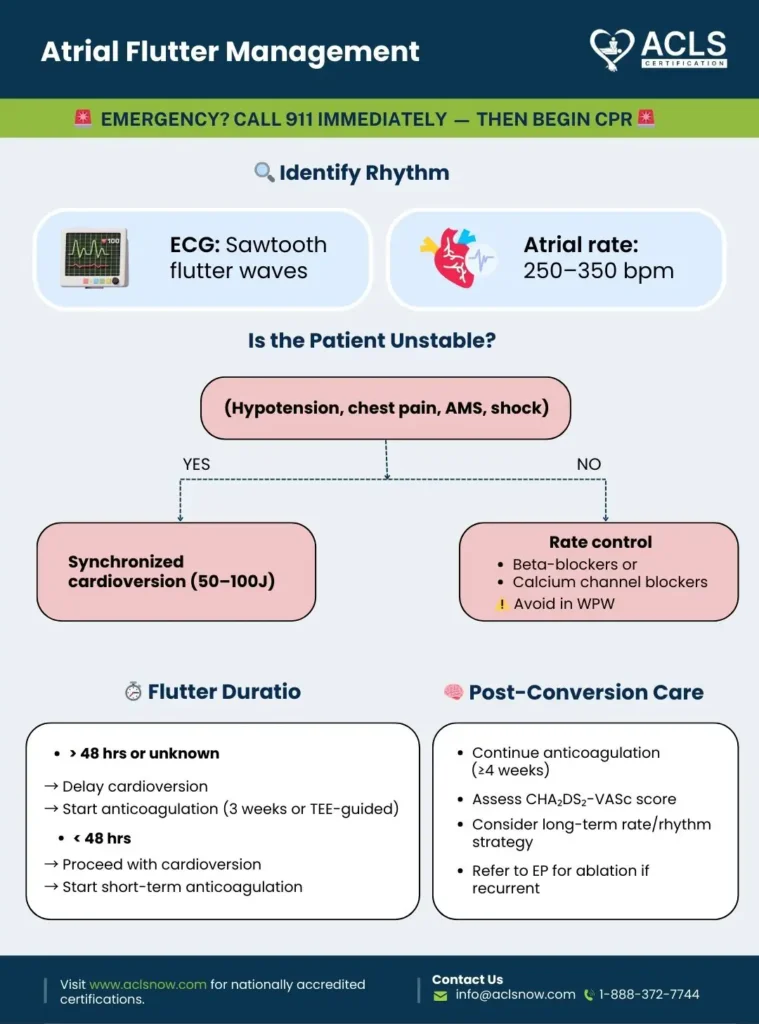Atrial flutter ACLS is a type of abnormal heart rhythm where the upper chambers of the heart (atria) beat very fast but in a regular pattern. This rapid beating causes the heart to pump less efficiently, which can lead to symptoms like palpitations, shortness of breath, and fatigue. It’s less common than atrial fibrillation but can still increase the risk of stroke and other heart-related issues. Treatment often involves medications or procedures to restore a normal heart rhythm.
One should distinguish atrial flutter from atrial fibrillation, as they are both related to arrhythmias but with very different characteristics and implications for study findings. In atrial flutter, a more organized pattern exists; it is irregular and chaotic in behavior in AF. A recent study found that survival rates for those with atrial fibrillation (AFib) were worse compared to similarly aged patients without AFib ACLS. In this article, we will discuss everything you need to know about atrial flutter and how it is treated.
Master PALS Now
Get PALS certified with confidence
What Is Atrial Flutter?
ACLS Atrial flutter is a type of heart rhythm disorder called arrhythmia. In this disorder, the upper chambers of the heart beat very quickly and regularly due to a problem in the heart’s electrical circuit. This can cause symptoms like a fast or pounding heartbeat, weakness, trouble exercising, shortness of breath, and feeling lightheaded.
Blood clots can form in the heart and travel to other parts of the body. Doctors diagnose atrial flutter with an electrocardiogram (ECG). Treatment usually includes medications to control the heart rate, blood thinners to prevent clots, and procedures to restore a normal heart rhythm. Significantly, there are two types of atrial flutter:
Read More: Acls discount code
Typical Atrial Flutter
Typical atrial flutter is a regular tachycardia in which the upper cardiac chambers—the atria—contract very rapidly and regularly. A circular electrical pathway in the right atrium causes this condition. Typical complaints of patients with this arrhythmia include palpitations, shortness of breath, fatigue, and dizziness.
The diagnosis is made with an electrocardiogram, whose characteristic pattern includes the appearance of teeth on the ST-T segment, the so-called “sawtooth” pattern. Treatment includes medications that slow down the heart rate, blood thinners to prevent clotting, and sometimes procedures that restore a normal heart rhythm.
Atypical Atrial Flutter
Atypical atrial flutter refers to the rapid pulsation of the heart but with much less regularity compared to the typical form. A flutter ACLS can originate from other places in the atria and not just from the right atrium. The symptoms are similar to those of the typical form, which are palpitations, shortness of breath, and fatigue.
Diagnosis, though, follows the same method as that of the typical form, which is ECG, but then the pattern may become less predictable and variable. The treatment of atypical atrial flutter mainly overlaps with that of typical atrial flutter and is thus focused on medicines, anticoagulants, and maybe procedures to restore a normal heart rhythm.
Master ACLS Now
Get ACLS certified with confidence
Causes of Atrial Flutter
Knowing the reasons for atrial flutter is crucial to managing the critical situation and treating the patient effectively. Atrial flutter ACLS is caused by different conditions such as:
- High Blood Pressure: This can be the reason for certain changes in the atrial tissue, causing it to be more susceptible to the dysfunctional rhythm of the heart.
- Coronary Artery Disease: CAD often reduces blood flow to the heart’s muscles, resulting in ischemia (lack of Oxygen).
- Heart Surgery: A previously done surgical procedure can affect the usual electrical pathways and potentially lead to atrial flutter.
- Electrolyte Imbalance: An imbalance in electrolytes such as magnesium or potassium can damage the electrical stability of the heart.
However, besides the above-mentioned causes, the symptoms of atrial flutter can occur due to an overactive thyroid gland known as hyperthyroidism, heart valve disorder, alcohol abuse, overdose of stimulants such as drugs like cocaine, diet pills, amphetamines, cold medicines, and even caffeine.
In ACLS AFib, the electrical stimulations that pass through the atria are usually disorderly and very fast, causing your heart to beat in a chaotic rhythm. Atrial Flutter, or in short AFL, can impact our daily lives significantly and causes complications and heart-related diseases.
Also Read: Identifying and Treating Atrial Fibrillation (AFib or AF)
Symptoms of Atrial Flutter
AFL can affect one’s day-to-day life activities. Here’s how:
- Chest Pain: You might feel tightness, pressure, or discomfort in your chest.
- Palpitation: Heart palpitation due to atrial flutter can feel like racing, fluttering, or pounding in the chest. It can happen when there is a short circuit in the heart, causing the atria to contract up to 300 times in a minute. This causes strain in the heart and increases the possibility of heart attack and stroke.
- Fatigue: Your heart’s inefficient pumping and rapidly increased heart rate can lead to decreased tolerance of exercise, loss of energy, and an overall feeling of fatigue.
- Shortness of breath: Atrial flutter can cause an abnormality in the normal heart rhythm, causing the heart to beat very quickly.
- Dizziness: It can also be another symptom of atrial fluttering. Fast heartbeats and decreasing cardiac system output can lead to dizziness or even fainting, inertia, and inactivity, affecting one’s ability to perform regular tasks.
- Fluid retention: You can experience the symptom of fluid retention when your ankles, feet, or legs are swollen due to heart failure.
An ACLS course can equip healthcare professionals with the skills needed to recognize and manage these symptoms effectively.
Diagnosis and Tests
If your doctor suspects that your heart is showing symptoms of atrial flutter, you should follow several steps as per the diagnosis of flutter ACLS. Here is a comprehensive overview of the essential diagnosis procedure and tools that you should use to take care of your heart after such a diagnosis.
- Identification of the previous medical history of the concerned patient is the most crucial part of the diagnosis.
- Doctors may ask you to do blood tests or lung function tests in order to test for overactive thyroid or chronic obstructive pulmonary disease (COPD), which can be a risk factor for atrial flutter.
- Doctors will ask you about certain symptoms, such as pulse, dizziness, shortness of breath, or fatigue. They will also review relevant medical history and then move on to the next step: asking you to do an Electrocardiogram (ECG/EKG) to measure and analyze the electrical activity of your heart.
Sometimes, you may be required to track your heart rhythm for longer than 48 hours. In this case, you will need an event monitor, sometimes called a cardiac event monitor. It is a type of portable ECG. Using the tool, you can detect arrhythmia manually when you are experiencing symptoms.
Also Read: Why is ACLS Certification Important for Healthcare Providers?
Management and Treatment
The management of atrial flutter may involve multiple approaches, including medications, lifestyle changes, and Afib RVR treatment ACLS to address rapid ventricular response. Medicines that control the speed of the heart or restore the heart rhythm to normal can be suggested, but the use of medicines comes broadly under treatment. Generally, the treatment involves the use of medicines that slow down the heart rate.
How ACLS Helps with Managing Atrial Flutter?
If atrial flutter causes serious symptoms and unstable blood flow, then a flutter treatment ACLS is advised, where electrical current is used to bring the heart back to a normal rhythm. Key points include:
- Immediate Cardioversion:
If the patient has unstable tachycardia from atrial flutter, immediate synchronized cardioversion is recommended. This involves delivering a shock to the heart at a specific time to correct the rhythm, following the ACLS Electrical Cardioversion Algorithm. For synchronized cardioversion, follow your manufacturer’s guidelines. The initial recommended dose for narrow regular rhythm is 50–100 acls cardioversion joules. For narrow irregular rhythm, use 120–200 Joules. For a wide and regular rhythm, use 100 cardioversion joules ACLS.
- Medications:
ACLS offers medication delivery recommendations for antiarrhythmic drugs such as adenosine, beta-blockers, or calcium channel blockers to maintain the rate and avoid further complications. Professionals trained in ACLS are competent at administering these medications, recognizing indications for their use, and monitoring patients for potential side effects.
Additionally, procedures like catheter ablation can treat atrial flutter by targeting and destroying specific heart tissues to stop the abnormal electrical signals.
Prevention of Atrial Flutter
There’s a saying, “Prevention is better than cure,” and this is completely true. Conditions related to the heart are crucial to prevent and treat. Preventive measures can be simple and effective if done correctly and for a prolonged period of time. Some of the preventive measures are:
- Maintaining a Healthy Body Weight: Body weight and the accumulation of unhealthy fats are among the most frequent risk factors for atrial flutter and other heart-related issues. Regular exercise and a healthy diet can help an individual maintain a healthy weight and avoid heart disease.
- Restricting the Use of Alcohol: Consuming high amounts of alcohol can lead to various health-related issues, specifically heart and liver diseases. Therefore, it’s good to avoid alcohol as much as possible.
- No Use of Tobacco Products: The common notion is that tobacco hampers only the lungs, but the prolonged use of tobacco has drastic effects on the heart and overall health.
- Keeping a Constant Check of Blood Sugar and Pressure Levels: Certain conditions, such as diabetes and high blood pressure, have negative effects on heart health, and if not checked properly, they can damage the organs.
Outlook / Prognosis
The condition of atrial flutter is rarely life-threatening only if proper preventive measures and proper treatment are not done once encountered. The patients diagnosed with this condition have an overall survival rate of 72.7% at 5 years. This condition increases the risk of stroke and heart failure if left untreated. However, with proper preventive measures, such as a healthy lifestyle and regular medical check-ups, many heart conditions can be managed or avoided altogether.
Final Thoughts
Atrial flutter is a serious heart condition that needs quick attention to avoid dangerous complications. Knowing its causes, symptoms, and treatments is key for early detection and management. While emergency care like Atrial flutter ACLS is important, preventing the condition through a healthy lifestyle and regular check-ups is even more crucial.
By reducing risk factors and getting timely medical help, people can greatly improve their chances and live better lives. Take charge of your heart health today for a healthier future.








